It’s hard to believe that almost eight weeks have passed since I was wrapping up the implementation phase of our fermentation experiments with smallholder farmers in Colombia. Our Experimentos En Cafe project gave these farmers technological toolkits, including a pH meter with which they could track their practices and with the hopes of determining optimal fermentation techniques.
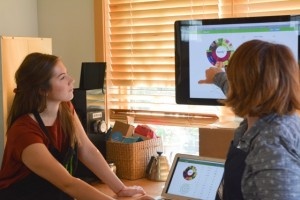 Back in the Portland office, the analysis phase is in full swing. I’ve traded my jet-setting schedule in Colombia for a regular nine-to-five work week, my heavy-duty boots for office attire, and my pH probe for a cupping spoon.
Back in the Portland office, the analysis phase is in full swing. I’ve traded my jet-setting schedule in Colombia for a regular nine-to-five work week, my heavy-duty boots for office attire, and my pH probe for a cupping spoon.
What exactly does this analysis stage look like? Over the past few weeks, the sample sets from Finca La Casiana, Finca La Victoria, Granja La Esperanza, and others have slowly made their way to the Portland office. By the time they reach us here, these samples have already been evaluated at origin by cooperative cuppers and our Sustainable Harvest® staff in Bogotá. With the help of our Quality Specialist Jessica Brooks and our sales team, we’ve been making our way through these coffees, scoring them carefully and compiling the results.
This is the satisfying part: seeing the hard work of our farmer partners with toolkits on the ground transformed into a finished product. Though we can’t draw conclusions from our data just yet, we have seen some really interesting sample sets showing a wide range of fermentation levels.
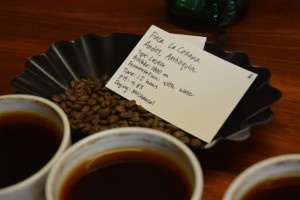 And yet, the intricacies of this crucial part of processing continue to reveal themselves. In multiple cuppings of one sample, we found a ferment defect present, coming out as pungent or moldy in the cup profile. But the odd thing about this sample was that it was fermented on the shorter end of the spectrum, for just 12 hours. While this may seem counterintuitive, it’s a good example that the negative qualities typically associated with over-fermentation can actually be the result of many other things. As Jessica reminded me during our cupping, this ferment defect could’ve been caused at other stages in the process—maybe by an unclean piece of equipment, or a mold that was growing on the fruit before it was even picked from the tree.
And yet, the intricacies of this crucial part of processing continue to reveal themselves. In multiple cuppings of one sample, we found a ferment defect present, coming out as pungent or moldy in the cup profile. But the odd thing about this sample was that it was fermented on the shorter end of the spectrum, for just 12 hours. While this may seem counterintuitive, it’s a good example that the negative qualities typically associated with over-fermentation can actually be the result of many other things. As Jessica reminded me during our cupping, this ferment defect could’ve been caused at other stages in the process—maybe by an unclean piece of equipment, or a mold that was growing on the fruit before it was even picked from the tree.
It makes sense then that with quality-oriented projects such as this one, the more cupping data we have, the better. So as we continue to evaluate the samples in our labs, we’re also involving roaster partners to cup the results. We’ve sent green sample packages out to national partners including Philz, Peet’s and Blue Bottle Coffee, where cupping teams are evaluating the results and sharing them with us through our cupping app Tastify™.
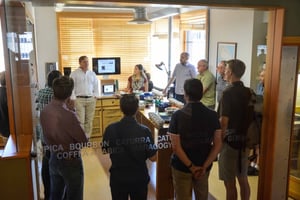 Amid all the analysis, the most exciting element for me has been preparing for a cupping event that took place this past Tuesday in our Portland lab. For this “Fermentation Cupping,” we invited local roasters, industry partners, and media to taste some of the results of our experiments in Colombia. The event was a fantastic opportunity to showcase the work of our cooperative partners with the coffee community and get important feedback on these samples.
Amid all the analysis, the most exciting element for me has been preparing for a cupping event that took place this past Tuesday in our Portland lab. For this “Fermentation Cupping,” we invited local roasters, industry partners, and media to taste some of the results of our experiments in Colombia. The event was a fantastic opportunity to showcase the work of our cooperative partners with the coffee community and get important feedback on these samples.
The six samples on the table represented two different coffees at three fermentation intervals, between 12 and 24 hours. Reviewing the Tastify™ wheels generated by these cuppers’ scores proved enlightening, as there was general agreement among those in the room that the coffee from Cooperandes’ Finca La Casiana improved in quality as the fermentation time increased.
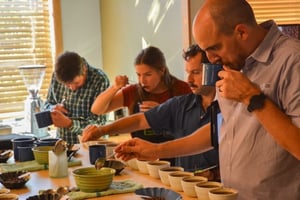 One particular sample stood out to nearly everyone: a Geisha variety from Granja La Esperanza’s Finca Cerro Azul, fermented for 13 hours to a pH of 3.73. While some – such as Nathanael May of Portland Roasting – called the coffee a favorite, others – like Mario Fernandez of the Coffee Quality Institute – identified something off in the cup, trending toward more vinegary notes. While flavor preferences will always vary from cupper to cupper, it was interesting to see how the fermentation experiment introduced a potentially divisive element to this particular cup.
One particular sample stood out to nearly everyone: a Geisha variety from Granja La Esperanza’s Finca Cerro Azul, fermented for 13 hours to a pH of 3.73. While some – such as Nathanael May of Portland Roasting – called the coffee a favorite, others – like Mario Fernandez of the Coffee Quality Institute – identified something off in the cup, trending toward more vinegary notes. While flavor preferences will always vary from cupper to cupper, it was interesting to see how the fermentation experiment introduced a potentially divisive element to this particular cup.
A good deal of analysis is still to come before we wrap up the project, but the cupping event certainly felt like a culminating moment—and a good reminder of exactly how much we’ve learned. While I still can’t call myself a fermentation expert by any means, I’ve come to know these samples and their pH curves like the back of my hand. And with each little surprise—a stubborn defect or a disagreement in the cupping results—I appreciate more and more the challenges farmers face when trying to control this complex process.
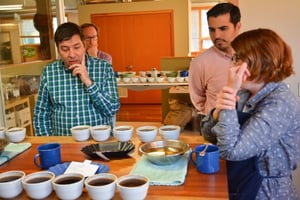 Tuesday’s event was also an encouraging sign that there is industry interest in continuing to refine fermentation, as many of our guests asked: What’s next for the toolkits? For now, we’re identifying a couple of farmer partners who can repeat the experiment, this time aiming for the optimal pH as a point to pull their coffee. Beyond that, we will continue looking for patterns in the cupping data and hone in on opportunities for further research.
Tuesday’s event was also an encouraging sign that there is industry interest in continuing to refine fermentation, as many of our guests asked: What’s next for the toolkits? For now, we’re identifying a couple of farmer partners who can repeat the experiment, this time aiming for the optimal pH as a point to pull their coffee. Beyond that, we will continue looking for patterns in the cupping data and hone in on opportunities for further research.



.png)
